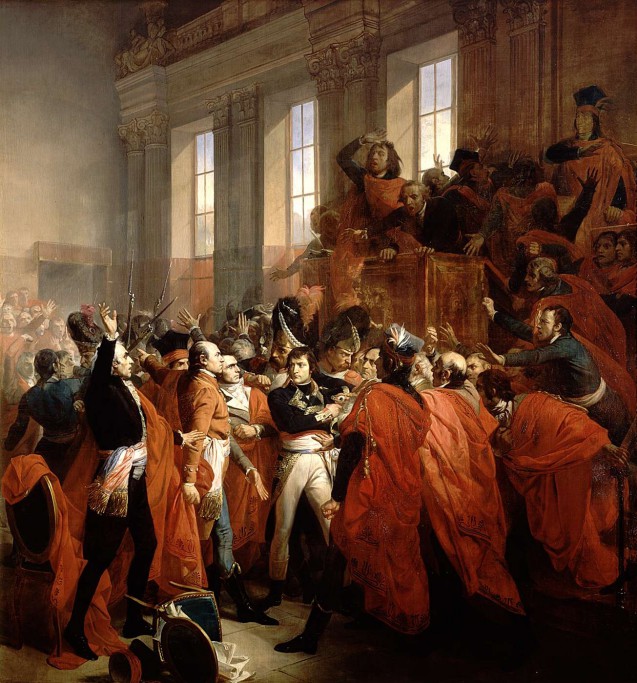This oil-on-canvas painting by François Bouchot (1800-1842) was executed in 1840 as a result of a commission in 1838 by King Louis-Philippe. The latter was attempting to harness in his favour a contemporary wave of nostalgia for Napoleon, in the wake of his dedication of the château de Versailles to all the glories of France. The painting was supposed to hang in the historical galleries in the museum at the château as a symbol of national reconciliation. Bouchot’s work was exhibited at the Salon of 1840, the year of the return of Napoleon’s mortal remains from St Helena to France.
François Bouchot studied at the Ecole des Beaux-Arts in Paris, won a Grand Prix de Rome in 1823, was made Chevalier de la Légion d’Honneur in 1835, and, before painting this work, had already received several commissions from Louis-Philippe, notably for The Battle of Zurich won by Masséna, 25 September 1799 painted in 1837.
The Brumaire Coup d’état
When General Bonaparte arrived in Paris on 16 October 1799, he found a situation very different from that which had left when he headed for Egypt in May 1798. The political establishment was unstable, and the Directory was bankrupt and considerably weakened. Over the whole period 1795-1799, there had been the (failed) ‘Conspiracy of the Equals’ (Conjuration des Égaux) headed by Babeuf (May 1796), the civil war in the Vendée (still rumbling on in 1799), the defection of General Pichegru to the Royalist side, and the war of the Second Coalition, not to mention the Fructidor coup d’état (1797) and subsequent proscriptions.
In late 1799, the Director Sieyès, disgruntled with the Jacobin party who had prevented him from effecting a revision of the Constitution whereby more power would be given to the executive, decided to organise a coup of which Bonaparte was to be the “enforcer”.
The days of 18 and 19 Brumaire, during which Sieyès and Bonaparte attempted to seize power, were not without their setbacks. Indeed, on his first low-key entry into the chamber on 19 Brumaire, Bonaparte was greeted with cries of ‘dictator’ and ‘outlaw’ and attacked.
Retiring but returning with a detachment of grenadiers (but also Generals Murat and Leclerc), Bonaparte took control of the sitting of the session of the Five Hundred in the Orangery of the Palace of Saint-Cloud. Legend has it that Murat laconically announced: “Citizens, your meeting is dismissed”, following it up with “foutez-moi tout ce monde dehors !” (“Get this ‘effing’ lot out of here”). The members were driven out through the windows and doors, only to be later driven back in to swear oaths to the new regime. The Directory was finished, the Consulate had begun.
Bouchot’s vision of the scene
This work by Bouchot designed to hang in Louis-Phillipe’s Museum of French History depicts the violent reaction of the Five Hundred to General Bonaparte’s first entrance into the council and to his words.
The scene is divided into three sections: top left, the tall windows show that the events are taking place in a vast hall containing the entire Five Hundred, and it is daytime; in the lower half of the painting, from left to right, stand the brightly lit key figures, including Bonaparte; an overturned chair (symbolising the overthrow of the regime) suggests the violence of the event; finally, top right, in a slightly less well lit part of the picture, several figures stand in the speaker’s platform, including Lucien, General Bonaparte’s brother, who had been president of the Five Hundred since October.
Napoleon Bonaparte is central to the painting: he wears a general’s uniform, including the red, white and blue Republican sash. Anti-historically, Bouchot has painted him calm despite the violent politicians gesticulating and shouting around him. The thirty-year-old general seems to have all the qualities required for leading France. Right behind him stand two mustachio-ed grenadiers with their celebrated bearskins attempting to protect their leader from the angry députés. The politicians wear different combinations of Republican red-white-and-blue sashes and red cloaks and square plumed hats, the uniform of members of the council of the Five Hundred.
Interestingly, despite the fact that Lucien’s role was integral to the coup d’État, Napoleon’s brother is set in the shade, mirroring the complicated fraternal relations during Napoleon’s rule.
Eymeric Job, Irène Delage and Peter Hicks
July 2019


